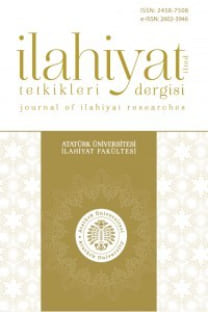Cemâl-i Halvetî’nin “Kitâbü’n-Nûriyye ve Kevkebü’d-Dürriyye” Adlı Tefsir Risalesinin Tahkikli Neşri
Bu çalışma, XV. yüzyılda yaşamış olan ve Çelebi Halîfe adıyla şöhret bulan Cemâl-i Halvetî'ye(v. 899/1494) ait bir tefsir risalesini gün yüzüne çıkarmayı amaçlamaktadır. II. Beyazıd devrindeyaşayan ve çok yönlü bir ilim adamı olan Cemâl Halvetî'nin tasavvuf, tefsir ve hadise dair pek çokeseri bulunmaktadır. Bu çalışmanın konusu olan Kitâbü'n-Nûriyye ve Kevkebü'd-Dürriyye adlıeser, müellifin temelde Nur 24/35 ayetinin tefsirini ele aldığı ve önemli gördüğü birkaç konuhakkında da değerlendirmelerde bulunduğu bir tefsir risalesidir. İşarî tefsirin karakteristiközelliklerinin görüldüğü bu risale, ilgili ayetin tefsiri bağlamında zaman içerisinde oluşan literatürünönemli bir parçasını oluşturmaktadır. Tahkikli neşir, eserin ulaşılan beş nüshası üzerindenyapılmıştır. Çalışmada, öncelikle Cemâl-i Halvetî'nin hayatı ve eserleri hakkında bilgi verilmiş,tahkikte esas alınan nüshaların tavsifi ve izlenen yöntem belirtilmiş ve eserin muhtevası hakkındayapılan kısa bir değerlendirmeden sonra metin verilmiştir
The Critical Edition of Jamâl-i Khalwatî’s Tafsir Leaflet Called “Kitâbu al-Nûriyya wa Kawkabu al-Durriyya”
This study aims to bring to light a tafsir (exegesis) leaflet which belongs to Jamâl-i Khalwatî (d.899/1494) who lived in 17thcentury and became famous with the name “Çelebi Halife”. Jamâl-iKhalwatî, who lived in the time of 2ndBayezid and who was a versatile scholar, wrote many bookson Islamic sufism, tafsir and hadith. The work called Kitâbu al-Nûriyya ve Kawkabu al-Durriyya,which is the subject of this study, is a tafsir leaflet in which the author basically deals with theexegesis of the verse 24/35 (Surah al-Nur) and makes evaluations on some points that he consideredimportant. This leaflet, in which characteristics of Ishari tafsir can be seen, forms a remarkablepart of the literature composed in time within the context of the mentioned verse. The verifiedpublication was made on the basis of the five attained versions of the work. In the study, firstlysome information about Jamâl-i Khalwatî’s life and works are given, the characterization of theversions that were taken as the base for verification and the method used are specified and the textis given after a short evaluation about the content of the work
___
- ISSN: 2458-7508
- Yayın Aralığı: 2
- Başlangıç: 1975
- Yayıncı: Atatürk Üniversitesi
